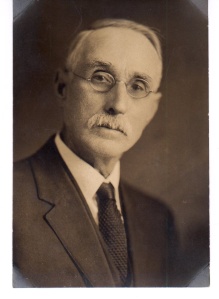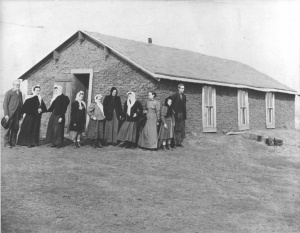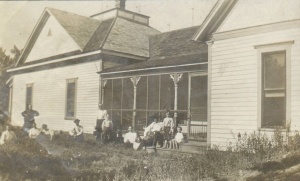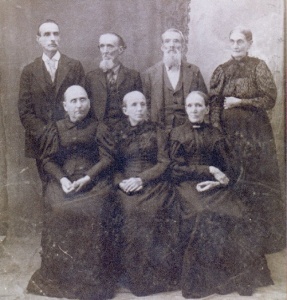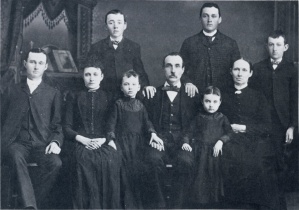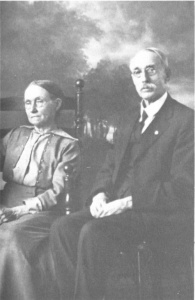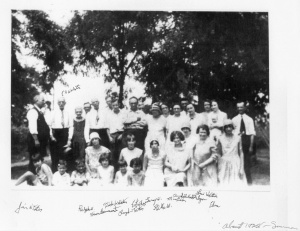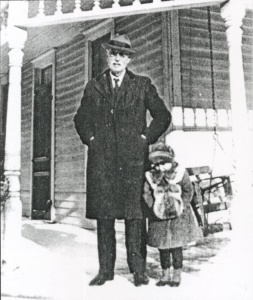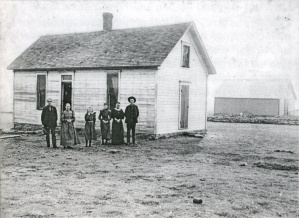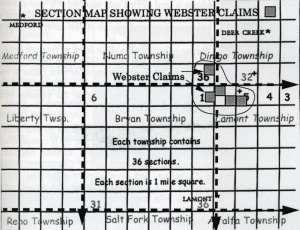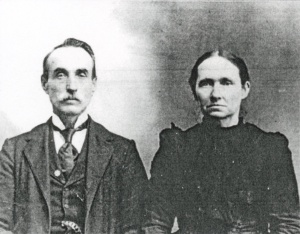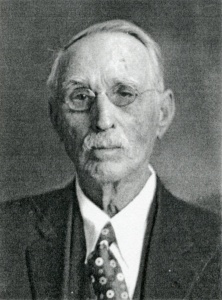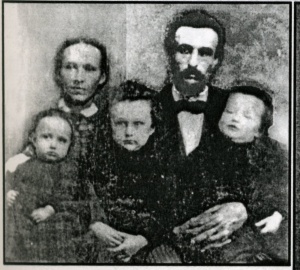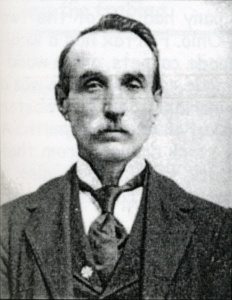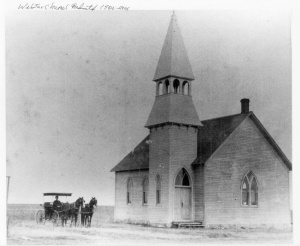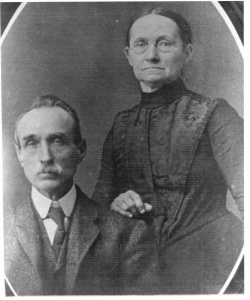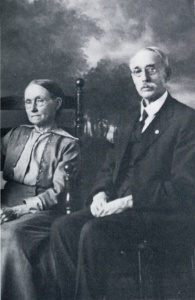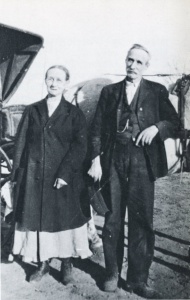

 Elijah Franklin Webster
Elijah Franklin Webster 

General Notes
Homestead: F3 Lots 3,4,5 and SE/4 NW/4 06 26N3W25 June 1901
Elijah was the youngest son of Thomas and Elizabeth Pulse Webster born in 1840 in Highland Co. Ohio. Elijah at one time joined two brothers in operating a General Merchandise Store in Fairfax, Ohio. At another time he was a salesman for Patent Medicines traveling by Horse and Buggy out of Cincinnatti, Ohio.
He did not involve himself in the Civil War. It was said that he hired a substitute (as was done by many men in the 1860s) to take his place in the Army. Two brothers and a nephew did serve in the Civil War.
Elijah did join a group called the "Squirrel Hunters" who were a loose organization of Farmer Patriots who took on the task of seeking out and capturing OUTLAWS who were preying on farmers, stealing livestock, destroying crops and other property, and in some cases murdering farmers and their families. "Squirrel Hunters" were recognized with Certificates of Appreciation and Participation after the War.
On July 24, 1879, The Concord IOOF-Sugar Tree Lodge No. 684 was organized. Charter members included E. F. Webster, L. F. Webster, and John Webster. Officers for 1880 included John Webster, N. G.
It was only five years later that E. F. Webster Family migrated to Sumner Co. Kansas in 1885 settling near Caldwell, Kansas. Elijah married Marry Elizabeth Ridings on Dec. 28, 1865 after the end of the Civil War. They were married at the village of Hollowtown in Clay Township, Highland County, where the Samuel Ridings Family resided.
Elijah took up farming in the Allensburg area near several brothers. All of their children except Elizabeth Ellen, were born in Highland County. In 1885, the Elijah Webster Family joined with the William Hanby Ridings family in migrating to Sumner County, Kansas.
The Websters settled temporarily in the Corbin, Kansas area a few miles east of Caldwell. The Ridings family settled in Caldwell. In 1885, Caldwell was still a rough town as a railhead for shipment of cattle driven from Texas over the Chisholm Trail.
The Websters farmed in the Corbin area but did not purchase land. In 1893, the Cherokee Outlet or better known as the Cherokee Strip was being opened for settlement. Caldwell became one of the staging areas for those hoping to stake a Claim in the new territory.
In September 1893, Elijah, his sons Leroy and Estridge and daughter Salena (Lena) made the run into the new territory and staked claims about 10 miles or so south of the Kansas border south of Caldwell. They all staked Claims close to each other north of Lamont and near what later became Deer Creek and Numa.
Estridge found another man had also staked on the same tract he was on and the man was a family man and Estridge was single so he vacated and returned to Caldwell-Corbin where he farmed on the land where the Websters had been living. He remained there for several years and married and later came to the Webster area and purchased a relinquished Claim.
Elijah and Mary Elizabeth Webster became leading citizens of the area and established a worship group first in their home and then a Sod Chapel was built known as Webster Chapel in 1894. In 1901 a frame Church was built to replace the Sod Church. Elijah and Mary Elizabeth were devout leaders in this new Webster Chapel and it became a Methodist Denomination and was a Charge on a Methodist Circuit.
This was a House of Worship for Websters and their neighbors until the death of Mary Elizabeth in 1921. After her death, the Chapel Building was moved into Deer Creek and attached to the Methodist Church there. The Chapel is still a part of the Deer Creek Methodist Church Building but is unused as the Methodist Church was closed some years ago by the Oklahoma Conference.
The Ralph Webster Family purchased the Church Property. As far as is known, the sons of Ralph still own the property.
In Oklahoma territory, Elijah was a Farmer-Rancher and a leader in the community. Elijah was a staunch Republican and had a deep interest in Politics. He cast his first vote in Ohio for Abraham Lincoln. He was proud of his voting record. He read newspapers thoroughly even in later years when he had to use a Reading Glass. He was hard of hearing in his late years.
After the death of Mary Elizabeth he lived with his children, each a month at a time. The Webster home was also a gathering place for social activities. Mrs. Webster (better known as Grandma) had a carpet loom in her home, and wove carpet and rugs for people for miles around. The people furnished the materials and Grandma wove it into 36 inch strips, then it was sewn together to make room size carpets.
Source: Lowell Shire, Descendants of Thomas F. Webster.
---------------------------
Elijah Franklin Webster, youngest son of Thomas Webster and Elizabeth (Pulse) Webster, was married to Mary Elizabeth Ridings, daughter of Samuel and Catherine (Ambrose) Riding in Highland County, Hillsboro, Ohio, in 1865. They lived on a farm west of Hillsboro, Ohio, where six children were born. In 1885, they moved by train, from Ohio, and settled in the Caldwell, Kansas area.
In 1886, another child, Elizabeth Ellen, the youngest of seven children was born. On September 16, 1893, the Cherokee Outlet was open for homesteading. Elijah Franklin Webster (better known as E. F. Webster) and three of his children made the ''run'' from the state border south of Caldwell. E. F. Webster, L. E. Wester, and F. Salena Webster staked on ground about half-way between Lamont and Deer Creek. E. F. Webster filed on and proved upon the NW 1/4 S 6 T26N R3W. This was their home the rest of their lives together.
After Mary Elizabeth's death in 1921, E. F. spent the winter months with his two daughters who lived in Blackwell, and the summer months with his sons, Roy, Lew, and Estridge on their farms. He lived to be 93 years old, dying in 1934.
L. E. Webster, better known as Roy, filed on and proved upon the SE 1/4 S 6 T26N R3W. In November, 1897, he married Estelle Mitchell. They lived on this quarter most of their lives, raising six children there, then retiring in Blackwell.
F. Salena Webster filed on and proved up on the SW 1/4 S ? T26N R3W. In March, 1898, Salena married Hiram S. Beaumont, who had made the run, and had filed and proved up on the SW1/4 S 6 T26N R3W where they lived until moving to Sheridan, Wyoming in August of 1914. They retained ownership of these properties.
Rosswell Estridge Webster, E. F. Webster's eldest son, staked a claim, but someone else had also staked it, so he returned to Caldwell, Kansas. On March 4, 1894, he married Catherine Teter, who lived east of Caldwell. They returned to Oklahoma in 1903, bought 80 acres of land, the S 1/2 of the NE1/4 S 1 T26N R4W and lived there for many years.
In 1904, another son, L. F. Webster, better known as Lew (who was too young to make the run) married Minnie Dorman, daughter of W. W. Dorman of Nardin, Oklahoma. They bought 160 acres, the NE 1/4 S36 T27N R4W. They lived on this farm until a tornado destroyed their buildings in 1954. They then moved to Lamont, and lived until their deaths.
On April 10, 1907, Elizabeth Ellen Webster was married to Emmet Lyon of the Nardin and Eddy, Oklahoma communities. They lived in Amarillo, Texas, for a time; returned to the Eddy-Nardin communities to live on various farms, later moving to Blackwell to make their home until their deaths.
On October 15, 1912, another daughter, Mary Jane, married James W. Teter and lived on a farm south of Deer Creek for several years. In 1916 they moved to Blackwell to live until their deaths. Before Janie, as she was called, was married, she gave piano lessons at home as well as driving for miles in a one horse buggy to give lessons to the children in the community.
One son, Hayward, drowned in the Pond Creek River one mile west of Lamont on July 24, 1895.
The E. F. Webster family was influential in the religious life of the community. They held church services in their home for several months. George James donated about 2 acres of land on the northwest corner of the NW 1/4S5-T21 - R 3W. A sod church was built. Services were held in it until 1900 when a frame church was built. It was called Webster Chapel. Sunday School and preaching services were held in it until about 1921 when the building was moved into Deer Creek and became the north wing of the present Methodist Church there.
In addition to the Websters being an inspiration in the community religious life, their home was the gathering place for social activities. Mrs. Webster (better known as Grandma) had a carpet loom in her home, and wove carpet and rugs for people for miles around. The people furnished the materials and Grandma wove it into 36 inch strips, then it was sewn together to make room size carpet.
This family of Websters struggled through all the hardships common to all the early settlers. People of those days raised most of their vegetables, meat, chickens, milk and butter, made their bread, spreads, and canned fruits from small orchards.
The schools were a one room building, with all eight grades in one room, and one teacher for all eight grades. The E. F. Websters had a beautiful peach and apple orchard on their farm where many people in the community came to get fruit. Mrs. Ralph Webster, "History of Grant County Families, " 1980.
-
Ancestor Pedigree Chart
-
*There are earlier generations for the ancestor(s) indicated. See their page(s) for details (click name) - b.07 May 1790 in Virginia d.07 Feb 1863 in Highland County, Ohio
- b.07 May 1790 in Virginia d.07 Feb 1863 in Highland County, Ohio

- b.03 Oct 1840 in Hillsboro, Highland County, Ohio d.30 Sep 1934 in Deer Creek, Grant County, Oklahoma




 - b.~ 1682 in Germany
- b.~ 1682 in Germany



 - b.15 Apr 1710 in Eggenstein, Karlsruhe, Baden, Germany d.Jul 1783 in Lebanon, Lancaster County, Pennsylvania
- b.15 Apr 1710 in Eggenstein, Karlsruhe, Baden, Germany d.Jul 1783 in Lebanon, Lancaster County, Pennsylvania







 - b.03 Mar 1733 in Eggenstein, Karlsruhe, Baden, Germany d.Jun 1806 in Jefferson County, Virginia
- b.03 Mar 1733 in Eggenstein, Karlsruhe, Baden, Germany d.Jun 1806 in Jefferson County, Virginia








 - d.< 1783 in Lebanon, Lancaster County, Pennsylvania
- d.< 1783 in Lebanon, Lancaster County, Pennsylvania






 - b.12 Mar 1768 in Derry twp, Lancaster County, Pennsylvania d.19 Sep 1849 in Lynchburg, Highland County, Ohio
- b.12 Mar 1768 in Derry twp, Lancaster County, Pennsylvania d.19 Sep 1849 in Lynchburg, Highland County, Ohio


 - b.1735 d.Aug 1806 in Jefferson County, Virginia
- b.1735 d.Aug 1806 in Jefferson County, Virginia
 - b.29 Aug 1796 in Middleway, Jefferson County, Virginia d.08 Apr 1860 in Highland County, Ohio
- b.29 Aug 1796 in Middleway, Jefferson County, Virginia d.08 Apr 1860 in Highland County, Ohio




 - b.17 Jun 1663 in Alsace, Germany d.~ 1734 in Montgomery County, Pennsylvania
- b.17 Jun 1663 in Alsace, Germany d.~ 1734 in Montgomery County, Pennsylvania



 - b.1703 in Montgomery County, Pennsylvania d.Mar 1753 in Frye Fort, Frederick County, Virginia
- b.1703 in Montgomery County, Pennsylvania d.Mar 1753 in Frye Fort, Frederick County, Virginia




 - b.Mar 1676 in Gemundeen, Germany d.~ 1755 in Montgomery County, Pennsylvania
- b.Mar 1676 in Gemundeen, Germany d.~ 1755 in Montgomery County, Pennsylvania


 - b.~ 1733 in Jefferson County, Virginia d.11 Dec 1804 in Jefferson County, Virginia
- b.~ 1733 in Jefferson County, Virginia d.11 Dec 1804 in Jefferson County, Virginia




 - b.01 Mar 1664 in Heilbronn, Germany
- b.01 Mar 1664 in Heilbronn, Germany



 - b.20 Mar 1699 in Bonfield, Germany d.27 Aug 1752 in Frederick County, Virginia
- b.20 Mar 1699 in Bonfield, Germany d.27 Aug 1752 in Frederick County, Virginia




 - b.~ 1666 in Bonfield, Germany d.~ 1717 in Philadelphia County, Pennsylvania
- b.~ 1666 in Bonfield, Germany d.~ 1717 in Philadelphia County, Pennsylvania

 - b.07 Apr 1769 in Jefferson County, Virginia d.30 Sep 1859 in Highland County, Ohio
- b.07 Apr 1769 in Jefferson County, Virginia d.30 Sep 1859 in Highland County, Ohio



-
 Details of Elijah's family with Mary Elizabeth Ridings
Details of Elijah's family with Mary Elizabeth Ridings
Source/Citation
History of Grant County Families, 1980
History of Grant County Families, 1980
